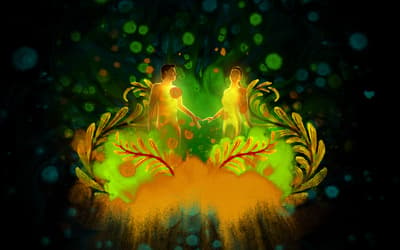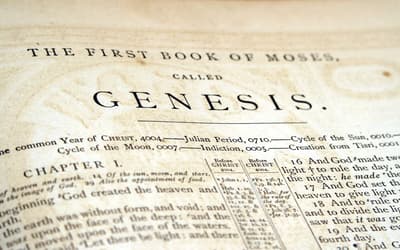Research conducted by Answers in Genesis staff scientists or sponsored by Answers in Genesis is funded solely by supporters’ donations.
Abstract
It has become popular in Christian circles to postulate that the Crucifixion occurred on April 3, AD 33. Often important in this conclusion is that there was a lunar eclipse that evening, with the assumption that the Apostle Peter’s quoting of Joel 2 at Pentecost about the moon being turned to blood is a reference to that eclipse. However, there is considerable doubt that this interpretation is correct, because this eclipse was far from total, and the moon rose over Jerusalem after maximum eclipse. The eye cannot observe the color of a partially eclipsed moon, so this eclipse could not fit the description of a “blood moon.” Assuming that Peter’s statement about the moon being turned to blood was a reference to some event at the time of the Crucifixion, it is far more plausible that unusual atmospheric conditions at that time were responsible.
Keywords: date of the Crucifixion, lunar eclipses, blood moon
Introduction
The full moon closest to the autumnal equinox long has been known as the harvest moon. The full moon following the harvest moon frequently is called the hunter’s moon, though the term blood moon occasionally is used. A totally eclipsed moon often has a red appearance, though the colors orange, yellow, gray, and even black are possible too. Because the most common color of a totally eclipsed moon is red, in recent years people increasingly have called an eclipsed moon a blood moon. This is the terminology that I will address here. However, only a totally eclipsed moon assumes an unusual color, and even a totally eclipsed moon may assume a color other than red. Therefore, one ought not to assume that any particular eclipse, past or future, necessarily had a red appearance.
The synoptic gospels record that on the day of the Crucifixion it was dark from noon until 3:00 pm (Matthew 27:45; Mark 15:33; Luke 23:44). Many have speculated on the nature of this darkness, suggesting things as diverse as miraculous darkness, unusual atmospheric conditions, a total solar eclipse, and the convolving of a lunar eclipse of the time with a solar eclipse through a scribal error. As for the total solar eclipse suggestion, it does not work on two counts. First, the maximum duration for a total solar eclipse is seven minutes, not three hours, and at the latitude of Jerusalem the maximum duration is even less. Second, a solar eclipse can occur only at new moon, but we know that Jesus was crucified at the time of Passover (Matthew 26:2; Mark 14:1–2,12; Luke 22:1–2, 7; John 13:1), and that the Passover is at the time of full moon (Exodus 12:1–11; Leviticus 23:5). Thus, while a solar eclipse could have happened two weeks prior or after the Crucifixion, it was not possible at the time of the Crucifixion. Since lunar eclipses occur only at full moon, a lunar eclipse is possible at Passover, and one could have happened at the time of the Crucifixion. However, any suggestion of a scribal error leading to the confusing of a lunar eclipse with a solar eclipse in the gospels must be vigorously opposed by those who have a high opinion of Scripture.
Humphreys and Waddington (1983) fixed the date of the Crucifixion at April 3, AD 33.1 They used several arguments that were sound enough, but they also noted that there was a lunar eclipse on that evening and suggested that a scribal error transformed the darkness of a lunar eclipse that evening into daytime darkness of a solar eclipse.2 Of course, this is a secular source, and the cavalier manner in which they invoked a scribal error reveals that Humphreys and Waddington had a low view of Scripture. Unfortunately, many Christians who hold the Bible in high regard have embraced this date of the Crucifixion, repeating and embellishing the significance of a lunar eclipse at the time of the Crucifixion. For instance, in his Star of Bethlehem DVD, Rick Larson argued for a later date for the death of Herod and thus a later date for the birth of Jesus to support his thesis regarding the identity of the Christmas star. This later dating inevitably leads to the AD 33 date for the Crucifixion. In his DVD Larson discussed what he thought was the significance of the lunar eclipse on the evening of April 3. I have previously discussed problems with this DVD (Faulkner 2010). More recently the well-known creation geologist Steve Austin also has endorsed the April 3, AD 33 Crucifixion date in a presentation that he has given many times,3 including at a meeting of the Geological Society of America (Austin 2012). Larson, Austin, and others argue that the lunar eclipse of April 3, AD 33 was a fulfillment of Joel’s prophecy of the moon being turned to blood quoted by the Apostle Peter at Pentecost (Acts 2:15–21). Young (2013a) recently published an article making this case as well. In a series of videos Mark Biltz has made similar claims about the AD 33 lunar eclipse and biblical prophecy, but especially he discusses a series of lunar eclipses that will occur in 2014–2015 and suggests that these eclipses will be harbingers of the Lord’s return. I have previously reviewed Biltz’s claims (Faulkner 2013).
There is doubt that Peter’s quotation of Joel at Pentecost or even Joel’s prophecy itself necessarily refers to a lunar eclipse. To stand out as a sign (Genesis 1:14), the moon turning to blood must be remarkable. However, a lunar eclipse by itself, though interesting, is hardly remarkable. Furthermore, the context of Peter’s quotation of Joel’s prophecy was to explain the miracle of how people from various parts of the world were able to understand in their own languages what Galileans were saying (Acts 2:4–13). This was preceded by the coming of the Holy Spirit (Acts 2:1–4). Peter related those two events to what Joel had written concerning the outpouring of the Holy Spirit resulting in people prophesying ({% scripture "Joel 2:28–29; Acts 2:17–18" %}). Peter went on to quote the rest of Joel’s prophecy (Joel 2:30–32; Acts 2:19–21) about wonders in heaven and earth and that salvation shall be made available to people outside of Israel. But the way of Gentile salvation came later, in Acts 10. Apart from Peter’s quotation of Joel, there is no mention in Acts of the wonders in heaven and earth that Joel’s prophecy foretold.4 The language from Joel about a darkened sun, a blood-like moon, and upheaval in the earth better conforms to the words of Revelation 6:12, which many view as still future events. Thus there is considerable doubt that Joel’s prophecy was completely fulfilled at the time of the Crucifixion or at Pentecost.
Was there a Blood Moon on April 3, AD 33?
In a companion article to his previously cited work, Young (2013b) explained why a totally eclipsed moon often has a red appearance, and hence could be called a blood moon. Because the earth has an atmosphere, its shadow (called the umbra) is not totally dark. Rather, the atmosphere refracts light into the earth’s shadow. This is why the sky doesn’t immediately turn dark after sunset. Additionally, the earth’s atmosphere scatters light that is bent into the umbra. This scattering is dependent upon wavelength, with shorter wavelengths being affected the most. Since in the visible part of the spectrum shorter wavelengths are blue and longer wavelengths are red, most of the blue light is scattered, leaving red to dominate the refracted light. This is why sunset and sunrise normally are red. Scattering also causes the earth’s umbra generally to be red, but not always. The color of total lunar eclipses can vary tremendously from eclipse to eclipse. This variation is attributed to atmospheric conditions along the edge of the earth through which the light travels. The most commonly reported color of a totally eclipsed moon is some shade of red or orange, though yellow is occasionally reported, and some eclipses are virtually black. Most unusual was the eclipse of July 6, 1982, one of the longest total lunar eclipses in history. A portion of the earth’s umbra was black as coal, but the rest was peach color. The earth’s umbra normally has uniform color and darkness, so this was a rare eclipse. It is important to note that with the wide variation in color and intensity in total lunar eclipses, it is presumptuous to assume automatically that any particular past or future total lunar eclipse did or will have a blood red appearance.
There are problems with claiming that the April 3, AD 33 lunar eclipse was a fulfillment of prophecy. First, one must assume that the sky was clear enough over Jerusalem that people could have seen the eclipse. More importantly, the April 3, AD 33 lunar eclipse was not total. This partial eclipse was far from total, and the maximum coverage of the moon occurred a half hour before the moon rose over Jerusalem that evening. When the moon rose, the lower right portion was outside of the earth’s umbra, and the partial eclipse ended about 45 minutes after rising. A small portion (far less than half) of the moon to the upper left was in the earth’s umbra (Schaefer 1990).5 A large portion of the moon not in the umbra was in the earth’s penumbra. The penumbra is the partial shadow of the earth, where the sun’s light is not completely blocked. While the penumbra is not fully illuminated, it is very difficult for the human eye to notice penumbral shading. This is because the eye adeptly compensates for the small drop in intensity. And there is only the subtlest of color change. Only right along the penumbra’s border with the umbra is any difference noted. The very slight color change in the penumbra as compared to the uneclipsed moon would require a very sensitive device for measurement. In short, in no way could the penumbra be described as red, let alone blood red. In his side bar, Young (2013b) understood this, for he wrote,
Penumbral eclipses are usually too faint to be observed by the unaided eye.
This correct statement contradicts (incorrect) statements made in his other paper (Young 2013a, p. 41). There a color illustration supposedly shows what the rising moon might have looked like from Jerusalem on that night. It shows a very red and darkened penumbral portion of the eclipse, and the caption reads, in part,
At this time, the upper left section was in the full shadow (umbra) of the earth, while the lower portion was in the penumbra (partial shadow). The color of the upper (umbral) portion would have been similar to what is shown in the previous picture, which shows the case when the entire moon is in the umbra.
The lower portion would have been a lighter red, fading possibly to yellow/orange. The lower portion was in the penumbra, which is “too faint to observed by the unaided eye,” so why did Young imply here that the eye could observe it? Earlier in this article (p. 39) Young had written,
These considerations for the special case of a lunar eclipse viewed at sunset mean that the fully eclipsed portion would not be just red, but dark red. Blood red. The portion in the penumbra (partial shadow) would show a lighter hue, red or possibly orange/yellow.
Again, this directly contradicts what Young wrote elsewhere. And on p. 40 he wrote,
Shortly after the sun set in the west, the moon rose in the east. It was dark. Dark red. Bloody red.
Besides falsely claiming that the penumbral portion was red, Young here assumes that all lunar eclipses are red, but that is not the case. The splendid colors of an eclipsed moon show up only when an eclipse is total. The portion of the moon that is not in the umbra is many orders of magnitude brighter than the umbral portion. We can’t easily see the color of a partially eclipsed moon because the faint light of the umbra is overpowered by the far brighter portion of the moon that is not in the umbra. The disparity in brightness makes it very difficult to ascertain the true color of the umbral portion, except when the eclipse is very nearly total, which this eclipse was not.
To be fair, Young did appeal to the moon being very low in the sky to enhance the red color. I previously mentioned this in the fact that the sun, or any other object such as the moon, appears redder when low in the sky due to the scattering of the earth’s atmosphere. However, to appeal to that much reddening due to the atmosphere eliminates the necessity of the moon being eclipsed that night. The rising or setting moon often appears deep red even when not eclipsed. Since this happens nearly every night, it is unlikely that normal reddening due to the atmosphere would constitute a fulfillment of prophecy. Many people already recognize that the darkness for three hours that afternoon likely was the result of unusual atmospheric conditions. If so, it is very probable that those conditions did not entirely clear by nightfall, which could account for an unusually red moon that evening, even without an eclipse. So this partial eclipse would have had little to do with the redness that might have colored the moon that night.
Another Important Lunar Eclipse
Historians generally date the Crucifixion to the range of AD 26–36. This comes from considerations of the biblical clues of the reigns of Herod, Pontius Pilate, and Quirinius. Important to the thesis of the April 3, AD 33 Crucifixion is the late date of Herod’s death. For a long time historians have thought that Herod died in 4 BC, and they generally continue to think so. If Herod died this early, then Jesus had to be born in or prior to 4 BC, even as early as 6 BC. Luke 3:23 tells us that Jesus started his ministry when he was about 30 years old, and the chronology of the gospels suggest that His ministry lasted a little more than three years. Assuming a birth year of no later than 4 BC (and recognizing that there was no zero year—1 BC was immediately followed by AD 1), we arrive at a Crucifixion date not much later than AD 30, possibly eliminating the AD 33 date. However, Hoehner (1977) holds to a 5/4 BC birth date of Jesus, and yet makes a persuasive case for an AD 33 crucifixion. He relies upon Luke’s statement of “about 30 years old” being just that—about 30 years, give or take a few years.
On the other hand, some have argued that Herod died later, in 1 BC, fitting well with the AD 33 Crucifixion date. The date of Herod’s death is computed from a mention in Josephus that Herod died shortly before Passover and that his death was preceded by a lunar eclipse. There were only two lunar eclipses shortly before Passover visible from Israel during the possible range of Herod’s death, one in 4 BC and the other in 1 BC. Most historians continue to believe the earlier date is correct, but in recent years many Christians have endorsed the later date of Herod’s death. Some undoubtedly are motivated by their desire to have the AD 33 Crucifixion date, but there are two arguments put forth in support of the later death of Herod. One argument is that the earlier date allows just a month for several events recorded by Josephus to occur (such as the execution of Matthias and Judas and their followers the day preceding the eclipse and Herod’s illness that led to his death). They argue that there was not enough time to accomplish these events in a month or less, but that the three months of the 1 BC window has enough time. The second argument is that the 4 BC lunar eclipse was partial but that the 1 BC was total and hence better conforms to what Josephus recorded. However, Josephus did not claim that the eclipse was total, but rather that the moon was eclipsed, so either a partial or total lunar eclipse would fit the description. On the other hand, proponents of this view claim that the partial eclipse of April 3, AD 33 accomplished something that only a total eclipse could do: give the moon a red appearance.
Conclusion
It has become common in Christian (and especially in creationist) circles to claim that the Crucifixion was on April 3, AD 33, and that the lunar eclipse that evening was a fulfillment of the Joel 2:31 prophecy of the moon being turned to blood. However, the large body of information concerning the appearance of lunar eclipses makes it very doubtful that the partial lunar eclipse that evening could have had an appearance that anyone would have described as a blood moon. It is questionable that Joel’s prophecy refers to the appearance of the moon that particular evening. But assuming that it does refer to the moon on the evening that Jesus was crucified, is there another explanation for a blood moon that evening? Yes. If the darkness the afternoon of the Crucifixion was caused by unusual atmospheric conditions, then it is likely that those atmospheric conditions did not totally clear by that evening and thus could have been responsible for a blood moon that evening, assuming that this is what Peter was referring to in his address at Pentecost. Of course, this would not require a lunar eclipse, so any other year would have worked as well.
I want to emphasize that I have no real quarrel with AD 33 date of the Crucifixion, though belief in it generally relies upon the late death of Herod, and most historians have yet to change their position on this. Most people assume that Jesus was crucified on Friday, with Passover on Saturday. There are only two years in the AD 26–36 window in which Friday immediately preceded the Passover, AD 30 and AD 33, and these are the two most popular dates for the Crucifixion. However, it is possible that Friday immediately preceded the Passover in AD 27 as well. Depending upon atmospheric conditions at the start of the month, Passover in AD 27 was either on a Friday or Saturday that year. And some people subscribe to the theory that the Crucifixion was on Wednesday or Thursday, with the Passover immediately following the next day. If this was the case, then the Crucifixion could have been in AD 27 (assuming a Friday Passover) or AD 34 (assuming a Thursday Passover). Thus it would appear that we have four possible years that the Crucifixion occurred.
Those who propose that the partial lunar eclipse on the evening of April 3, AD 33 was the fulfillment of Joel’s prophecy mean well, but there is a downside. Many Christians find significance and meaning in that astronomy may offer some evidence of events surrounding the Crucifixion. However, lunar eclipses are not that rare and a partial eclipse fails to qualify as a blood moon. If a lunar eclipse is what Peter was referring to when he quoted the prophet Joel at Pentecost, then that hardly was a remarkable fulfillment of prophecy. The skeptic can just as easily respond that early Christian leaders merely wove current natural events (such as a lunar eclipse) into their narrative, and thus this proves nothing. Either approach conforms to a particular worldview. Ultimately this appeal to a partial lunar eclipse fails to explain the blood moon anyway, so I urge Christians to avoid this argument.
References
Austin, S. A. 2012. Jerusalem earthquake of 33 AD: Evidence within laminated mud of the Dead Sea, Israel. In GSA Annual Meeting & Exposition. Retrieved from https://gsa.confex.com/gsa/2012AM/webprogramadapt/Paper204688.html.
Faulkner, D. 2010. An evaluation of The Star of Bethlehem DVD. Retrieved from http://www.answersingenesis.org/articles/aid/v5/n1/star-of-bethlehem-dvd.
Faulkner, D. 2013. Will lunar eclipses cause four blood moons in 2014 and 2015? Retrieved from http://www.answersingenesis.org/articles/2013/07/12/lunar-eclipses-cause-blood-moons.
Hoehner, H. W. 1977. Chronological aspects of the life of Christ. Grand Rapids, Michigan: Zondervan.
Humphreys, C. J. and W. G. Waddington. 1983. Dating the Crucifixion. Nature 306, no. 5945:743–746.
Schaefer, B. E. 1990. Lunar visibility and the Crucifixion. Quarterly Journal of the Royal Astronomical Society 31, no. 1:52–67.
Young, R. C. 2013a. How lunar and solar eclipses shed light on biblical events. Bible and Spade 26, no. 2:37–43.
Young, R. C. 2013b. Eclipses: The science and the pseudoscience. Bible and Spade 26, no. 2:44.








